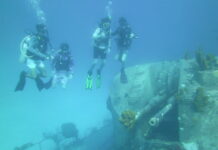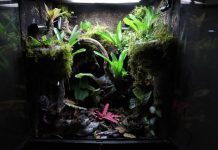Eighty feet below the surface of the ocean, just off the coast of Salt Island in the British Virgin Islands, the RMS Rhone, a 310 foot sunken British packet ship lies still, resting on the sand. After 145 years, the RMS Rhone is teeming with life ranging from corals to stingrays to barracudas. Up at the surface, nineteen Jesuit divers are putting on gear and checking their air tanks as they prepare to plunge into the crystal clear waters below.
Back in January, Jesuit sophomores and juniors had the chance to apply for the Marine Biology course. This course counts for half a science credit, meaning that if a student completes both the Marine Biology 1 and the Marine Biology 2 courses, he will not have to take a science course during his senior year. The course is run by Dr. Todd Gruninger, Biology teacher, and Mr. Ben Kirby, Assistant Principal of Academics and former biology teacher. This trip marked the fourth year of the trip, and according to both Mr. Kirby and Dr. Gruninger, the trip is not going anywhere soon and is here to stay. The program is highly organized each year by Mr. Kirby and Dr. Gruninger who have partnered with Jeff and Casey McNutt, the owners of Dive BVI and who work on organizing this trip several months in advance. Mr. Kirby mentioned that Jeff and Casey “shut down their whole business for two weeks” in order to guide the guys who go down every year.
Before the students can leave for the trip, they must first undergo scuba classes in order to dive while down in the BVI. In the classes, students learn how to monitor their air consumption, how to perform emergency ascension and rescue procedures, and how to control their buoyancy, a particularly useful skill that allowed students to plant coral without breaking it and without damaging any coral already in the wild. Although the classes were fairly long, taking up 2-3 days of class time and another 2 days of applied testing at Clear Springs Scuba Park, the course was extremely comprehensive and made sure each student was prepared to dive without the help of a dive master. Chris Ayres ’15 mentioned that although the certification took a while “it was definitely worth it to be able to dive.”
 Day 1: The guys, led by the dive experts at dive BVI, jumped on their assigned boats and went down to the famous dive site, The Chimney, favorite dive site of Jacques Cousteau, famous explorer, marine conversationalist, and inventor of the aqua lung, one of the first regulators used to breath underwater. At the Chimney, the divers had the chance to swim in between two large rocks that create a narrow passage that resembles a chimney. At the dive site, there were countless different forms of wildlife such as spotted moray eels, puffer fish, and lionfish.
Day 1: The guys, led by the dive experts at dive BVI, jumped on their assigned boats and went down to the famous dive site, The Chimney, favorite dive site of Jacques Cousteau, famous explorer, marine conversationalist, and inventor of the aqua lung, one of the first regulators used to breath underwater. At the Chimney, the divers had the chance to swim in between two large rocks that create a narrow passage that resembles a chimney. At the dive site, there were countless different forms of wildlife such as spotted moray eels, puffer fish, and lionfish.
Day 2: The guys were treated to a tour of The Baths, a famous and unique geological formation of massive boulders that creates tidal pools and gorgeous grottoes. After The Baths and a quick lunch, everyone hopped on their assigned boats and went to an island named “Ginger’s Backside.” Here, the guys dove for a little while and observed the wildlife. After the dive, some of the less fortunate divers noticed their sunburns. Even though they were not terrible after only two days, the sunburned made sure to apply sunscreen constantly and treat any sunburns with aloe.
Day 3: This day had a promising start with a breakfast of donuts. After breakfast, Dr. Shannon Gore, a guest speaker and expert on marine life in the BVI gave a presentation on turtle identification and turtle tagging, a process where researchers catch turtles, mark or “tag” them, and release them back into the wild and monitor their habits. After the presentation, everyone was able to go turtle tagging! This was an especially rare opportunity as it is normally illegal to even touch the turtles, but because Dr. Gore was with them, they were able to chase the turtles.

The class split into two groups. One group went with Dr. Gore to tag turtles while the other group went to the beach for a lesson on fish identification by Caitlin, one of the employees down at Dive BVI who was especially keen on identification, utilizing her “fish identification bible” to teach the guys about different skills such as identifying the type of beak and looking at the shape of the fins.
After the lesson, Caitlin had prepared a tub of various little creatures for everyone one to look at and even some to feel! These ranged from slugs to sea urchins. Meanwhile, the other half of the students were on the boats chasing turtles. They set the boat to the buoy and got to work. Halfway through their work, it started raining heavily. The guys who were on the buoys and the guys who were watching the lines to make sure nothing happened were pelted by the rain and battered by a biting wind.
Despite their best efforts, the turtles proved too fast and maneuverable in the water for the guys of the first group to catch. At Midday, the two groups switched, one half studying fish identification at the beach while the other group went turtle tagging. The second group managed actually managed to catch a turtle which they named “Chadd.”

Day 4: The most important part of the trip, the coral planting, came on this day. Jesuit has worked long and hard to build the Jesuit Reef, a reef of manually planted coral by various years of marine biology students from Jesuit that has begun to draw in new life to a previously desolate area.
At the start of the day, everyone was split into groups that went in search of pieces of coral that could be saved from dying or bleached coral. Basically, they were removing living parts of otherwise dead coral. With this healthy coral, they then went to the Jesuit Reef and attached these pieces to cinderblocks using zip ties. By fastening the coral down to the cinderblocks, the guys knew that the coral wouldn’t be blown away and die.
Garrett Buckley ’15 said that “the coral reef planting was a lot of fun because we got to experience what real marine biologists do in the field.”
After transplanting all of the coral, the marine bio students jumped back on the boats, went back to the resort to get changed and shower, and went to church at a small chapel on a hill overlooking the island, a truly beautiful view. Later that night, there was a barbecue and a night snorkel. During the night snorkel, a few guys were hit by needle fish that were jumping at them because they were drawn to the flashlights. Later during the night snorkel, everyone turned off their lights and saw amazing bioluminescence from the tiny little organisms floating around them.
Day 5: A two-dive day, this was the day of the RMS Rhone dive. At the ship, the divers were amazed to see wildlife such as turtles, sting rays, and even a pair of barracudas, a somewhat rare sight because barracudas generally travel alone! Also, Michael White ’15 managed to kill a lionfish with a speargun, an invasive species wreaking havoc on the Caribbean’s ecosystem. After surfacing to switch tanks, the guys dove back down to the boiler room and the famous cabin 26, rumored to give wealth, good food, and beautiful women to whoever rubs the window three times. After the dive, everybody was treated to a first class meal of fish and chips which was almost unanimously dubbed the best meal ever.
Day 6: The final day was the group’s service project. The service site was a beach that was nearly completely coated in trash, because of the way the current pushed all the trash to this one spot. After nearly two hours of cleaning, the beach was in a considerably healthier condition. Garret Buckley ’15 noted that he “especially enjoyed [the] service project because [they] were cleaning up a beach that was definitely in need of [their] help. Among various fishing lines, there were bottle caps, knives, lighters, and soda cans washed up on the beach. All in all, the guys filled up 20-30 trash bags with the beach litter.
In conclusion, this trip was both a great experience for the students and helped the ecosystem of the BVI. It is a great opportunity for Jesuit students, as most people do not have an opportunity nearly as amazing as this one in their entire lives. Dr. Gruninger and Mr. Kirby were especially pleased with the trip, commenting fondly on the student’s behavior and willingness to learn and help. Mr. Kirby mentioned that the program “isn’t going anywhere” and that he expects it to grow even more. Lastly, when asked if he saw any room for improvement in the trip, both Chris Ayres and Garrett Buckley simply replied “no.” saying that it was the perfect experience.






